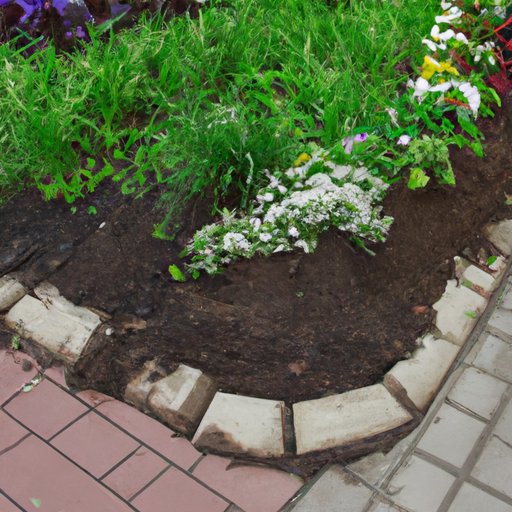Introduction
Flower beds are an easy and affordable way to turn any outdoor space into a vibrant and inviting landscape. They can add color, texture, and life to an otherwise dull yard. Whether you’re a beginner gardener or a seasoned expert, this guide will walk you through the steps of making your own flower bed.
In this article, we’ll cover the basics of creating a flower bed, including factors to consider before starting, types of plants that thrive in flower beds, designing the shape and size of your flower bed, planting and caring for your flower bed, and creative ideas for decorating your flower bed.
Lay Out the Basics: An Introduction to Creating Flower Beds
Before you start digging, it’s important to consider a few key factors that will help ensure success. These include choosing the right location, deciding on a design, and estimating space needs.
Choosing the Right Location
The first step in creating a flower bed is to choose a spot in your yard that gets at least six hours of sunlight each day. Avoid low-lying areas that may collect water, as this could cause root rot. You should also take into consideration any existing trees or shrubs nearby that might cast shade. If necessary, trim back branches to create more light.
Deciding on a Design
Next, decide on a design for your flower bed. Will it be curved or straight? Will it have a formal or informal look? Consider the overall style of your home and landscape when making this decision. Also think about the size and shape of your yard and how the flower bed will fit within it.
Estimating Space Needs
Finally, estimate how much space you need for your flower bed. Measure the area where you plan to put the bed, then subtract any permanent fixtures such as trees, pathways, and fences. Then, determine how many plants you want to include, taking into account their mature size. This will give you an idea of how much space you’ll need for your flower bed.

Choosing the Right Plants for Your Flower Bed
Once you’ve determined the location and size of your flower bed, it’s time to choose the right plants. Different varieties of flowers and plants thrive in flower beds, so it’s important to consider which ones would work best in your climate and environment.
Types of Plants That Thrive in Flower Beds
Annuals are popular choices for flower beds because they bloom throughout the growing season. Examples of annuals include marigolds, petunias, and impatiens. Perennials come back year after year and often require less maintenance than annuals. Some perennials to consider for your flower bed are daisies, black-eyed Susan’s, and lavender. Shrubs and trees can also be included in flower beds for dimension and texture. Popular choices include hydrangeas, rhododendrons, and evergreens.

Designing the Shape and Size of Your Flower Bed
Now that you’ve chosen the plants for your flower bed, it’s time to design the shape and size. To do this, you’ll need to understand the principles of design.
Understanding the Principles of Design
When designing a flower bed, there are three main principles to keep in mind: color and texture, balance and proportion, and focal points. Color and texture refer to the colors and textures of the plants you choose. Balance and proportion refer to the placement of plants in relation to one another. And focal points refer to the main attraction of your flower bed. Consider adding a birdbath, statue, or other decorative elements to draw the eye.
Planting and Caring for Your Flower Bed
Once you’ve designed the shape and size of your flower bed, it’s time to plant and care for it. This includes preparing the soil, planting and watering, providing nutrients and mulching, and pruning and deadheading.
Preparing the Soil
Before planting, you’ll need to prepare the soil. Start by removing any weeds or debris, then use a shovel or tiller to loosen the soil. Next, add compost or fertilizer to improve the soil quality and provide essential nutrients for your plants. Finally, use a rake to level the soil and create a flat surface for planting.
Planting and Watering
Once the soil is prepared, it’s time to plant your flowers and plants. Dig holes slightly larger than the root balls of the plants, then place them in the holes and fill in with soil. Water your plants immediately after planting and continue to water regularly to keep the soil moist but not soggy.
Providing Nutrients and Mulching
To ensure your plants get all the nutrients they need, fertilize your flower bed every few weeks during the growing season. Also consider adding mulch to help retain moisture and suppress weeds. Organic mulches such as wood chips or shredded bark are great options.
Pruning and Deadheading
It’s also important to prune and deadhead your plants to keep them healthy and looking their best. Pruning involves trimming back overgrown branches and stems, while deadheading involves removing spent blooms. Doing both of these tasks regularly will help encourage new growth and flowering.

Creative Ideas for Decorating Your Flower Bed
Once your flower bed is planted and cared for, it’s time to add some finishing touches. Accessories like garden ornaments, pathways, edging, and ground covers can help create a unique and inviting space.
Adding Accessories
Garden ornaments such as statues, birdbaths, and wind chimes can add a touch of whimsy to your flower bed. Pathways and edging can provide a clean border around the bed and make it easier to maintain. Finally, ground covers such as moss and creeping thyme can help reduce weeds and add texture to your flower bed.
Conclusion
Creating a flower bed can be a fun and rewarding experience. With a little planning and preparation, you can create a beautiful outdoor space that will last for years to come. By following the steps outlined in this guide, you’ll be well on your way to creating a stunning flower bed of your own.


